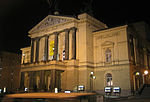The Prague uprising (Czech: Pražské povstání) was a partially successful attempt by the Czech resistance movement to liberate the city of Prague from German occupation in May 1945, during the end of World War II. The preceding six years of occupation had fuelled anti-German sentiment and the rapid advance of Allied forces from the Red Army and the United States Army offered the resistance a chance of success.
On 5 May 1945, during the end of World War II in Europe, occupying German forces in Bohemia and Moravia were spontaneously attacked by civilians in an uprising, with Czech resistance leaders emerging from hiding to join them. The Russian Liberation Army (ROA), a collaborationist formation of ethnic Russians, defected and supported the insurgents. German forces counter-attacked, but their progress was slowed by barricades constructed by the insurgents. On 8 May, the Czech and German leaders signed a ceasefire allowing all German forces to withdraw from the city, but some Waffen-SS troops refused to obey. Fighting continued until 9 May, when the Red Army entered the nearly liberated city.
The uprising was brutal, with both sides committing several war crimes. German forces used Czech civilians as human shields and perpetrated several massacres. Violence against German civilians, sanctioned by the Czechoslovak government-in-exile, continued after the uprising, and was justified as revenge for the occupation or as a means to encourage Germans to flee. George S. Patton's Third United States Army was ordered by Supreme Allied Commander Dwight D. Eisenhower not to come to the aid of the Czech insurgents, which undermined the credibility of the Western powers in post-war Czechoslovakia. Instead, the uprising was presented as a symbol of Czech resistance to Nazi rule, and the liberation by the Red Army was used by the Communist Party of Czechoslovakia to increase popular support for the party.










